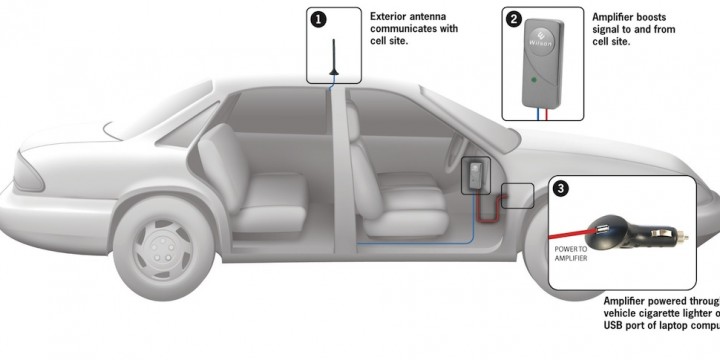
Wilson Electronics Cell Phone Booster
- October 2014
- Gadgetry
I first heard of the Wilson Electronics cell phone booster when I was climbing at Maple: a friend had a huge antenna rigged up in the campground and some solar panels. Intrigued, I asked him what it was all about, and he explained he can get work done on climbing trips by boosting his cell signal and using the phone as a hotspot. So this was obviously getting way too complicated for me, but what I took away was that there’s a thing out there that makes your cell phone work better in crappy service range, which is where I spend about 80% of my time, so that was pretty interesting….
So imagine my surprise when I learned that Wilson Electronics is based in Saint George, Utah! Being a proud Utahn myself, I instantly felt a sense of local kinship, and I guess they do too, because they kindly sent me two products to try out in the black holes of Moab and beyond: the Mobile 4G Booster and the Sleek 4G.
Now if you are like me, your eyes are already glazing over and this is way too complicated/technical to even try to understand, so let me sum it up 🙂 The Mobile goes in your car and makes all the cell phones in the car work better. The Sleek also goes in your car but has a phone cradle, and the phone has to be in the cradle to work better, so it’s good for one person. As soon as I figured this out, I decided to try the Mobile in my car, and gave the Sleek to my best friend Lisa to test out in her truck–she does wilderness study work by hooting for owls all night in remote canyons, and is always way out of cell range. Lisa’s (far more technical and thorough) review of the Sleek is below.
I have to be honest, as soon as I see black plastic boxes and antennas and stuff I get very nervous and would rather clean the bathroom or mow the lawn, so I cleverly handed the whole thing to my boyfriend and came back later to find a little magnetic antenna on top of my car with a wire neatly running below the door gasket and below the driver’s seat, so I have to say installment was a snap (Lisa’s actual installment review is also below–apparently it’s super easy). Basically, you plug in the cigarette lighter part and that powers the booster. I learned that you don’t want to leave it powered on when the car is off or your battery dies (I’m sure this is covered in the instructions). There are many places in Moab where you have 1-2 Gs of signal, and many more places where your iphone shows the 1X with very few bars. This means you can’t use your phone, send a text or (worst of all!) post any Instagrams.
I found that the booster doesn’t make magic–you’re not going to go from no signal to full 4G, as much as we wish that could happen…. However, there are many spots where the booster now allows me to get a text out or in, and even occasionally takes me from no Gs to a 3G signal. Living in Moab where you get out of cell range within a few miles of town, this can be a real advantage.
Here’s what Lisa has to say about the cradle version (thanks Lisa!):

The Wilson Sleek® 4G is a cell phone signal booster, designed to better access cell tower signals to boost the voice and data signal of one’s mobile phone device when in areas of spotty cell coverage. It purports to work for all carriers and to boost all signals up to 4G.
If you are a quick-and-nasty type of review seeker, go no further than this: if you frequent the boonies, don’t leave home without it! I’d give this device an B+ overall, with an A for what matters most: providing a signal boost to one’s mobile phone device. For those curious of the specifics of successes and fails of the Sleek®, read on!
The Basics:
So one thing I personally like to see with any electronic device is intuitive usability. The Sleek® definitely succeeds in that category. I essentially dumped the contents from the box, ignored the packaging and instructions and set the booster up in about two minutes. The most “challenging” task was running the cable from the antenna into the cab in a nice tidy fashion. That took about 1.5 of the 2 minutes. The remaining 30 seconds were consumed by screwing in the cable and plugging in the USB cord to the charging unit.
After setting it up, I noticed the usb plug on the side. Theoretically, one can charge her phone and boost a signal at the same time, though most car cigarette lighter ports (are they still called that?? charging ports?) state only 12v can be properly powered at a time. Even if one doesn’t intuitively grasp how to set up an antenna, a glance at the box should suffice. (I still haven’t read the directions which may even address the aforementioned power draw issue, but I’ve not been compelled by any lack of performance to do so.)
I chose to not attach the cradle holder to my vehicle as I wanted it to easily transfer from vehicle to vehicle.
Set Up: A+
Performance:
The outer packaging of the box of Wilson Sleek® claims the Sleek® will 1.) work with all major carriers; 2.) boost all data speeds, including 4g; 3.) amplify the signal while phone is in the cradle; and 4.) extend the battery life of one’s cell phone.
I can’t speak to the first as I only have Verizon as a carrier, but one would assume that should be pretty standard fare unless there is some sort of dark magic out there I’m unaware of. (In this neck of the woods, Verizon is by far the most reliable and wide-spread signal provider, so I’m sure an ATT user would have different results from mine, but she would be starting out with a different access issue to begin with.)
Claim 1: Carrier Coverage: A for VZW, N/A for others
By default, a better amplified signal will logically enhance data speeds so two and three are essentially hand-in-hand. As a roving wildlife biologist who spends a ton of time in “the hinterlands”, I have quite a comprehensive knowledge of —quite literally—the exact spot a mobile signal will degrade or disappear in this neck of the woods. So this made assessing the second claim fairly simple. And my experience was that it absolutely did boost my access. I would say on average I could count on a two bars boost on our 3G network. Or a boost from “1x” to “3G”. Sometimes however, the latter is more of a hassle than a benefit as one’s phone may be desperately try to hit a zero-one bar 3G out and thus not get the signal when a four bar 1x might. There is a caveat: Though the signal was clearly boosted where ever I’ve previously had any degree of signal, there were, alas, no miracle boosts. Those spots historically “no service” remained resolutely and consistently so. I serial dialed my voice mail on a stretch of road where I previously had at best limited text (not imsg) service and I’d say I got out 3/5 times.
Claims 2 and 3: B+/A-
As far as improving battery life, I’d take that with a pretty large chunk of salt! This is a tough metric and is very usage dependent (voice vs data), but in general, I didn’t notice anything remotely gobsmacking with run time on my phone. And in some situations, such as signal fringe areas, I noticed that my phone would be frantically trying to acquire a signal when previously it would just give up, thus using more battery than it ordinarily would. As far as data is concerned, the simple fact that things would get in and out much more readily would logically imply better battery usage, if one only did that one task or a few tasks. But if you sit there for twenty minutes sending one email or ten, I seemed to find the battery drained equally.
Claim 4: A bit disingenuous as a round claim, but arguably true if one is trying to get a limited amount of info in/out, so we’ll call it A-, limited to specific task use, C- for continuous use over a fixed amount of time.
Critiques notwithstanding, let’s don’t forget I say A- overall for this unit!!! If one is in a sitch and needs to get assistance or any kind of emergency call out, she’d want to have this in the quiver and would be grateful for the access! I’ll never leave home without this again and as it turns out, neither will quite a few of my similarly-employed peers who choose this very model. But if one is truly going to be in the depths of a canyon or remote corner of life, the Sleek® can’t create miracles. For that, we still need a satellite communicator/locator.








[…] antennas – We haven’t used them before, but Steph Davis has some reviews of the Wilson Electronics Booster and the weBoost Connect and vouches for […]
[…] antennas – We haven’t used them before, but Steph Davis has some reviews of the Wilson Electronics Booster and the weBoost Connect and vouches for […]